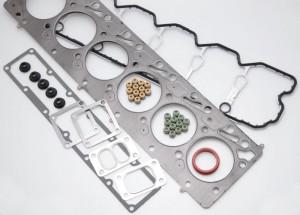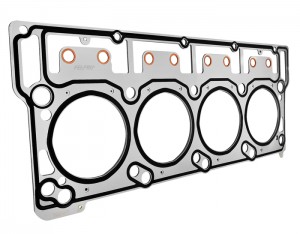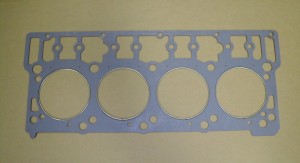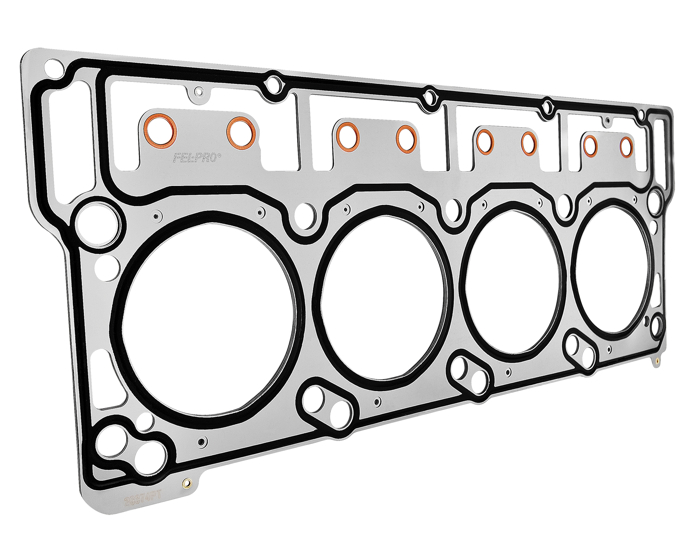 Head gaskets have a tough job sealing combustion pressures in diesel engines because of their high compression ratios and boost pressures. Diesel engines are typically low revving, high torque motors that are designed to last several hundred thousand miles. The stock head gaskets that are used in most light truck diesel engines are robust enough to handle peak combustion pressures in the 1800 to 2200 PSI range, but may not do so well at higher pressures if the engine has been tweaked to produce more power.
Head gaskets have a tough job sealing combustion pressures in diesel engines because of their high compression ratios and boost pressures. Diesel engines are typically low revving, high torque motors that are designed to last several hundred thousand miles. The stock head gaskets that are used in most light truck diesel engines are robust enough to handle peak combustion pressures in the 1800 to 2200 PSI range, but may not do so well at higher pressures if the engine has been tweaked to produce more power.
The cheapest and easiest route to more power for towing or pulling is to change the engine control software. Tuner scan-tool software can be downloaded into the engine PCM to replace the stock engine calibration settings. Custom tuning programs crank up the boost pressure and increase duel delivery and injection timing to add 100 to 150 rear-wheel horsepower in many applications. But this also increases the peak combustion pressures in the cylinders when the engine is running hard. Some custom tunes can push peak combustion pressures into the 2500 to 2700 PSI range or even higher.
The stock head gaskets in most diesel engines can handle a moderate increase in power with no immediate problems, but for how long is anybody’s guess. That’s why some OEMs will not honor a powertrain warranty claim if the stock programming has been modified or overwritten with a custom tune. Reloading the stock tune to conceal the modification doesn’t hide what’s been done either because the PCM keeps a record in memory of when its programming was last modified.
As for heavily modified diesel engines with multi-stage turbos, insane boost pressures and/or secondary fuel injection (ethanol, methanol or propane), head gasket sealing can be even more of a challenge. Now we’re talking cylinder pressures that can go well beyond 3,000 PSI and well beyond the sealing capabilities of a stock head gasket. For these kinds of applications, performance gaskets are an absolute must.

Problem Applications
GMC Duramax and Dodge Cummins diesel engines tend to have few head gasket problems in stock or slightly modified form because they have six head bolts around each cylinder. The Duramax engines have 18 head bolts per cylinder bank, while the inline Cummins six cylinders have a total of 24 head bolts. Using additional head bolts helps spread the clamping load more evenly around the cylinders and between the individual head bolts. Ford has also used six bolts per cylinder on its 6.7L and 7.3L Powerstroke engines, but only four head bolts per cylinder on the 6.0L and 6.4L Powerstroke engines. Fewer bolts means more stress and load on each of the bolts.
The 2005 to 2007 6.0L Ford Powerstroke engines are famous for blowing head gaskets even with no engine modifications. The stock torque-to-yield head bolts tend to stretch, which reduces the clamping force on the head gasket causing the gasket to leak and fail. The problem with these engines is not the stock head gasket so much as it is the loss of clamping force due to head bolt stretch.
One recommended fix for these engines is to replace the stock head bolts with a full set of high strength aftermarket head studs, especially if the engine is being modified in any way to produce more power (including a custom power tune).
Another recommended fix is to replace the stock head gasket with a re-engineered aftermarket MLS head gasket that uses better embossments, stronger materials, extra sealing rings and/or superior high temperature sealing materials around the coolant and oil openings.
Adding an extra, embossed layer to an MLS gasket allows it to retain its clamping load better and to resist head lift without leaking. Some of these upgraded aftermarket MLS head gaskets can easily double the service life of the head gasket over the stock head gasket. The extra layers of embossed spring steel help the gasket maintain tension between the head and block. This reduces the amount of clamp load the head bolts have to provide to maintain a long lasting seal, which reduces the risk of bolt stretch, gasket leakage and failure.
Some of these gaskets also feature a folded stainless steel ring around each combustion chamber that acts like a fire ring to help seal pressure. The added thickness of the sealing ring concentrates the clamping force around the cylinder to withstand higher peak combustion pressures.

When To Upgrade
One aftermarket gasket manufacturer we interviewed for this article said engine builders should upgrade to a performance head gasket anytime a diesel engine is being modified for more power. As peak cylinder pressures rise, so does the risk of head lift, cylinder head bolt stretch and loss of clamping force on the gasket. This can lead to loss of combustion pressure, coolant leaks, oil leaks and gasket failure.
Performance diesel MLS head gaskets use the most durable materials as well as additional layers and/or sealing rings around the combustion chambers. The use of a sealing ring helps concentrate the clamping force around the cylinder for a better combustion seal. When used with a good set of head studs, a performance head gasket should be able to handle up to 3,000 horsepower without failing, assuming the engine is put together properly and that the head and block deck surfaces are flat and within the recommended surface finish specifications.
Copper Head Gaskets
Another option for a high output diesel engine is to go with a copper head gasket. Copper head gaskets are usually pure copper, annealed to make them hard enough to withstand the rigors of sealing an engine. The gaskets are available in various thicknesses ranging from .020˝ up to .120˝ depending on what you want. They are also available with a rubber coating (RCC or Rubber Coated Copper) to make cold sealing easier (bare copper does not seal fluids very well).
Copper head gaskets are typically used in high output drag racing or pulling engines that produce upwards of 800 to 1,000 horsepower. Copper is a good material for these high load applications because it can take the heat. But copper has little conformability, which means cold sealing coolant and oil openings can be tricky.
Copper head gaskets are often used with sealing rings around the combustion chambers. The engine block and/or head is machined to create a shallow receiver groove for a stainless steel O-ring. If a wire diameter of .041 inches is used, a groove .039 inches wide by .029 inches deep will allow the wire to protrude about .012˝when used with a .040˝-thick copper head gasket. The wire ring helps concentrate the clamping force around the cylinder and combustion chamber.
As one gasket manufacturer said, copper head gaskets are great for racing. But once you go to an O-ringed block or head, you’re stuck with it. You can’t change back to an MLS gasket unless you go to a different block or head. People have tried filling in the grooves for a sealing ring with a high temperature epoxy so they can switch back to an MLS gasket, but it usually doesn’t work very well.

Clean, Smooth And Flat
Flatness is absolutely critical to get a leak-free, long-lasting seal with any head gasket. Measuring flatness is relatively simple provided you use a straight edge that is truly flat to within 0.00002˝ per foot. Most factory specs say flatness should be 0.1 mm (.004˝) or less in any direction for a diesel cylinder head and block. That might be okay for a stock rebuild, but it’s too sloppy for a highly loaded performance engine build. Aim for .002˝ (.05 mm) or less out-of-flat in any direction, with .001˝ or less being ideal. Pay close attention to the areas between the combustion chambers on the cylinder head because lack of flatness here can lead to combustion leaks and gasket failure.
Surface finish is also critical to preventing a head gasket failure. A typical recommendation for a diesel engine using an aftermarket MLS head gasket would be 30 to 60 micro-inches RA (Roughness Average). Many MLS gaskets have an outer coating of nitrile rubber, Viton or other material to improve cold sealing. The thicker the coating, the rougher the finish the gasket can accommodate without leaking. Most original equipment MLS gaskets have a much thinner coating and require a much smoother (20 to 30 RA) surface finish. Some aftermarket performance MLS gaskets also have raised sealing beads printed around the coolant and oil passages to improve sealing.
Accurately measuring surface finish requires more than guesswork. It requires the right kind of resurfacing equipment, the proper feed and speed rates for milling, sharp tooling and the right type of tooling inserts (PCD works best for aluminum while CBN is best for iron). It also requires a profilometer to check your work. Roughness Average (RA) is only one of several perimeters that can be measured. A more accurate perimeter is “Rz,” which is the average difference between the peak height (Rpk) and valley depth (Rvk). RA can have a wide variance across a given surface profile, so Rz gives a more accurate indication of the actual texture across the surface.
If you are using a profilometer to check surface finishes, use the Rz readings rather than the RA to see what’s really going on. A 20 RA surface finish for an original equipment MLS head gasket would be about 120 Rz. For an aftermarket performance MLS gasket, look for Rz readings in the 180 to 300 Rz range. A surface that is too rough can leave gaps between the gasket and metal.
If you are deck plate honing the engine block (which you should be to minimize bore distortion and piston ring blowby), use the same type of gasket that will eventually be used on the engine with the deck plate.
Bolt Torque
A long lasting, leak-free head gasket seal also requires proper loading of the head bolts. Torque specs will vary with the engine, as will the tightening procedure. For a stock engine build with torque-to-yield head bolts (which should always be replaced with new bolts and never reused), follow the OEM sequence for tightening the bolts. Make sure your torque wrench has been accurately calibrated and that you use an angle gauge for the final tightening sequence (don’t just guess at the angle).
Most TTY head bolts should be lightly lubricated with engine oil, although some new original equipment TTY head bolts (like 6.6L Duramax) come pre-coated with lubricant so no additional lubricant or oil should be used. Many engine builders prefer to use an aftermarket head bolt thread lubricant rather than oil. Some of these products offer much more consistent torque readings than motor oil or a moly grease. If using head studs instead of bolts, follow the stud manufacturers torque recommendations as they will likely differ from the stock head bolts due to the stronger alloys in the studs and their reduced tendency to stretch when fully loaded.
Special appreciation to these suppliers for their assistance with this article: Cometic Gaskets, Fel-Pro/FP Diesel, Hypermax Engineering, Magnum Gaskets and MAHLE Aftermarket. For contact information for each of these manufacturers and suppliers – as well as others – visit our online interactive Buyers Guides at www.EngineBuilderMag.com.














